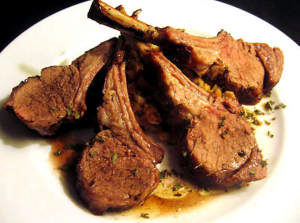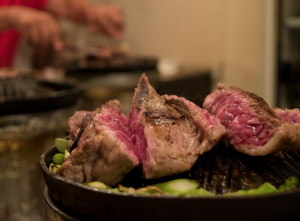First off, let us get straight about what lamb is. Lamb is the name we use for the meat of young sheep. Older sheep’s meat is called mutton. The meat of lambs, that is sheep that is less than one year old is called lamb. Lamb is a very big part of the cuisine of the United States, Europe, and some parts of Asia.
Being the youngest sheep meat out there, lamb is also the most expensive and least fat one. Still, being red meat, lamb is not necessarily good for your overall health. Like all things, it is about moderation when it comes to consuming lamb. In this article, we will try to explore issues such as: Is lamb red meat and why? Is lamb good for you and what kind of nutritional composition does lamb have. So how rich in nutrients is the lamb? Well for this article we take a look at a 3 oz serving (85g) of lamb meat. A serving will contain about 180 calories on average, with the leaner parts containing as little as 150 and the fat parts as much as 250 calories. The leanest part of the lamb will be its top leg meat, which has the most muscle and least fat.
Lamb Meat Nutrition
So how rich in nutrients is the lamb? Well for this article we take a look at a 3 oz serving (85g) of lamb meat. A serving will contain about 180 calories on average, with the leaner parts containing as little as 150 and the fat parts as much as 250 calories. The leanest part of the lamb will be its top leg meat, which has the most muscle and least fat. When it comes to fats there is really a huge difference in different parts of the animal. A portion of leg meat will have as little as 5 grams of fat while a portion of the rib may have about 11 grams and a portion of ground lamb meat will go as high as 17 grams of fat per portion. The fats in lamb are divided up just about equally between the saturated and the unsaturated.
Next up, we take a look at the protein. Like most meats, lamb is rich in protein. The 85 g portion contains about 25 grams of protein on average, a very significant percentage of the recommended daily intake for adults which tends to be about 70-80 grams of protein. The same serving also contains about 80 g of cholesterol which is about 25%-30% of the RDI.

When we take a closer look at lamb and look into the vitamins and minerals in it, we can see that lamb does contain some healthy nutrients. For instance, about 100 grams of lamb will give you all the Vitamin B12 you need in a day, as well as 40% Zinc, 25% Iron, and 20% Riboflavin. These are all important to our health and in this way lamb can be good for you.
Compared to most other red meats, lamb is actually leaner and less fat, being very young meat. The overall amount of calories from lamb will be somewhat lower than that of pork or beef and the fats will also be lower. That said, the numbers are not that far apart and you will be mistaken if you think you can eat two or three times more lamb without consequences.
Lamb Health Benefits
To get things straight right off the bat, eating too much lamb will be BAD for you, absolutely. The amount of fats, cholesterol, and overall calories is simply really high, so lamb meat should really be eaten in moderation. That said, let us have a look at the good in lamb meat for a second.
For starters, like all meat, the lamb will be a great source of protein and high-quality protein at that. A portion of just 85 g contains 25 grams of protein and this is probably the portion you should put your limits at. 100 g of lamb in a meal is sufficient. It will give you the protein and it will limit the Negative stuff.
On the mineral front, the lamb is a great source of iron and zinc. A portion of lamb can give you about 25% of the daily iron intake and 50% of the zinc intake and it is an animal source, the minerals should metabolize faster than other sources. Lamb is also a fantastic source of Vitamin B12 and you can easily take all of your daily Vitamin B12 from lab meat. While lamb meat is fat, half of those fats are the unsaturated fats, which are actually good for you, so it is not all that bad.
The Cons
The main downside of lamb meat is the high-calorie count. I remember just recently going to a restaurant with a friend and he ordered this stuff. The waiter brought a 300 g portion and I remember thinking, wow this is insane. While many people may find lamb meat insanely tasty (I personally don’t), it is a very caloric food and should be taken in absolute moderation.

The cholesterol and sodium present in lamb meat also force the moderation factor. While cholesterol needs to be a part of your diet, eating about 250-30 grams of lamb meat will satisfy your daily cholesterol needs. That means anything else you eat afterward will cross the threshold and cause negative effects. High cholesterol levels are linked directly to heart disease and blood pressure issues.
When it comes to sodium, meat, especially processed meat contains pretty high levels. Especially elderly people should be super careful eating processed meat, and even fresh meat still needs to be eaten in moderation.
Conclusion
Many of my personal friends and family can’t resist lamb and while I am personally not a huge fan, I understand that people on average love this stuff. From an absolutely natural angle, lamb is good meat, rich in protein and the likes of zinc, iron, and Vitamin B12. The most important thing to note is moderation. Don’t go out and eat hundreds of grams per day or you will gain weight, take in excess cholesterol and end up with cardiovascular issues.
Once in a while, feel free to have a 100-200 gram portion of lamb and preferably go and exercise the same evening. Your body will thank you and you will feel better. Eating this stuff all the time will make you slow and lazy, but keeping it in your diet as a delicious treat will be great. Enjoy your lamb.
Image Rights
Images used via the creative commons version 2.0 license – https://creativecommons.org/licenses/by/2.0/
Image One by museinthecity – https://www.flickr.com/photos/49651178@N00/2269798293/
Image Two by Refia – https://www.flickr.com/photos/rfa/2852770375/